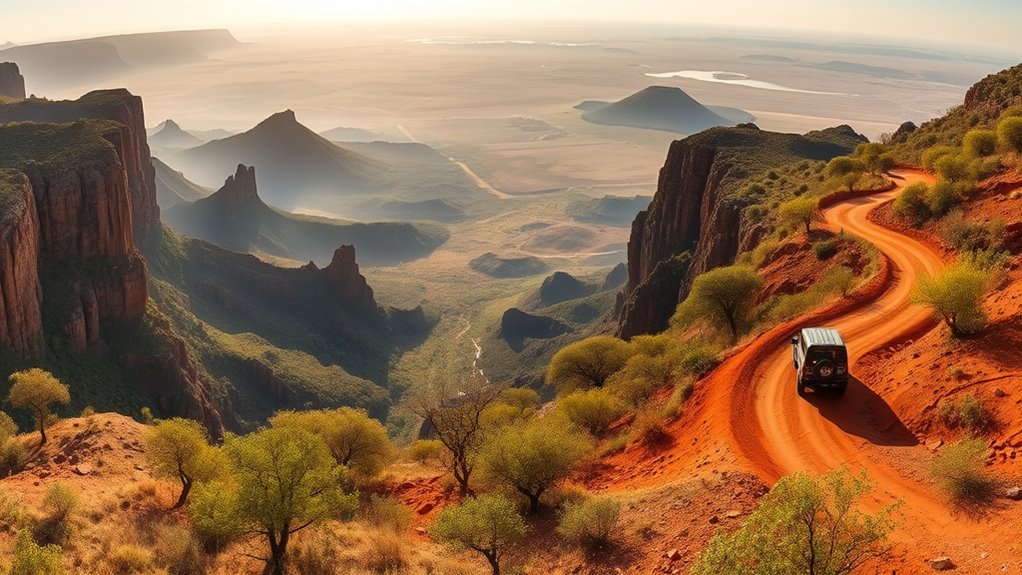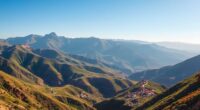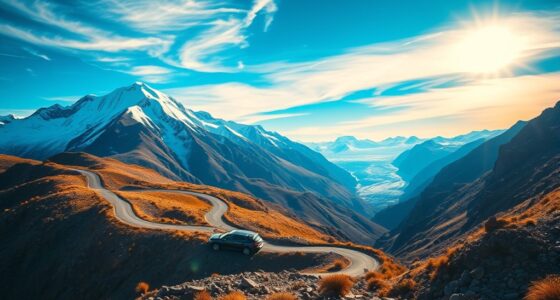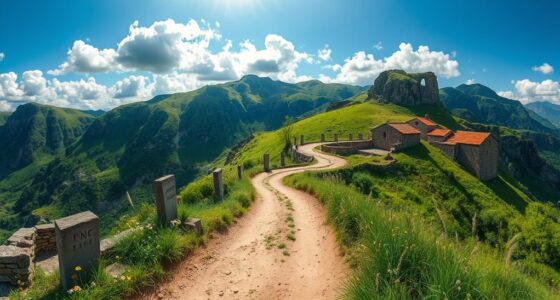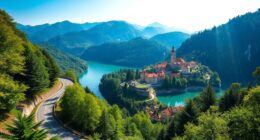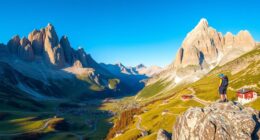Driving Kenya’s Great Rift Valley Escarpment takes you through lush farmland, vibrant towns, and rugged terrain with stunning views of lakes, cliffs, and wildlife. You’ll see flamingos in Lake Nakuru, spot elephants on open plains, and enjoy panoramic vistas over Maasai Mara. Stay alert for wildlife crossings and local villages where you can experience Maasai culture. For more scenic spots, wildlife encounters, and travel tips, keep exploring this beautiful region.
Key Takeaways
- Use well-maintained roads and GPS to navigate the scenic route along the escarpment safely.
- Drive at moderate speeds to enjoy the spectacular views of cliffs, lakes, and distant mountains.
- Be alert for wildlife crossings and slow down in animal-prone areas, especially near national parks.
- Plan your trip during dry seasons (June-October, January-February) for optimal visibility and better road conditions.
- Explore key landmarks such as Lake Naivasha, the Great Rift Valley cliffs, and panoramic vistas for a memorable experience.
The Scenic Route: From Nairobi to the Escarpment

As you leave Nairobi, the journey to the Great Rift Valley Escarpment unfolds along a scenic route filled with striking landscapes and changing vistas. You’ll pass lush farmland, dotted with vibrant crops and grazing livestock, giving way to rolling hills that stretch toward the horizon. The road winds through small towns and villages, where local markets and roadside stalls add bursts of color and life. As you ascend higher, the terrain becomes more rugged, revealing rocky outcrops and open savannahs. The air shifts slightly, carrying a sense of adventure and anticipation. Every turn offers new views, from distant mountain ranges to expansive plains, making the drive not just a route but a visual journey into Kenya’s diverse natural beauty.
Key Landmarks and Natural Wonders Along the Drive

Along the scenic drive from Nairobi to the Great Rift Valley Escarpment, you’ll encounter a series of remarkable landmarks and natural wonders that highlight Kenya’s diverse landscape. First, you’ll pass the breathtaking view of the Great Rift Valley itself, where jagged cliffs plunge into vast, shimmering lakes. Scenic landscapes such as these are characteristic of the region’s geological formation. Next, Lake Naivasha comes into view, a lush freshwater haven teeming with birdlife and hippos. The area around the lake is also known for its vibrant ecosystem, which supports a variety of flora and fauna unique to the region. Finally, as you descend, the escarpment reveals its rugged beauty, with striking rock formations and panoramic vistas. These landmarks not only showcase nature’s artistry but also set the stage for the adventure ahead. The journey is a visual feast that immerses you in Kenya’s extraordinary geological and ecological diversity. Dog quotes can provide a delightful break during your trip, offering moments of humor and reflection to enrich your experience.
Cultural Encounters With the Communities of the Rift Valley
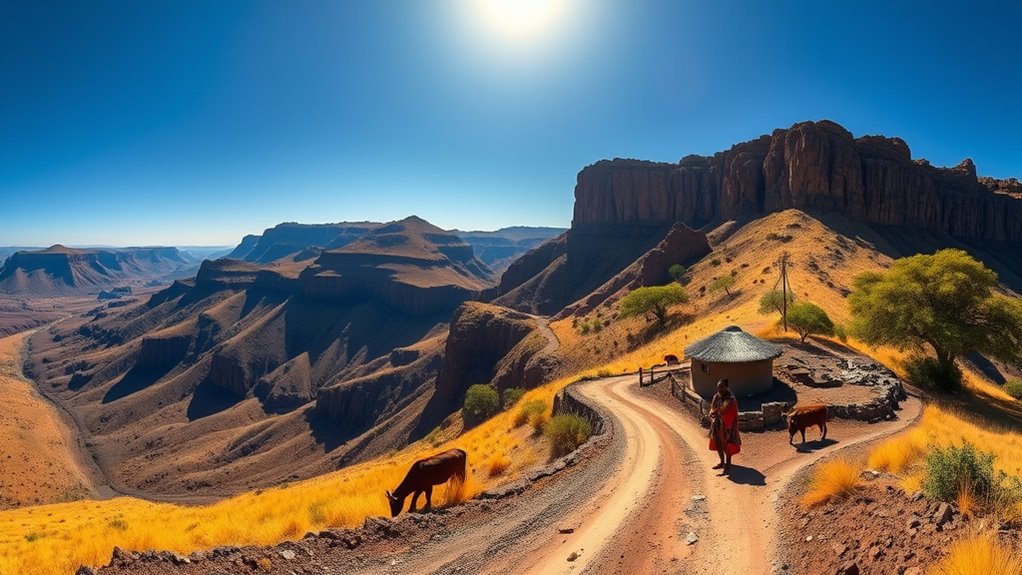
Standing amidst the stunning scenery of the Rift Valley, you’ll find yourself immersed in the vibrant cultures of its communities. As you visit local villages, you’ll witness traditional dances, colorful ceremonies, and age-old customs that have shaped their identities. Engaging with Maasai elders, you’ll hear stories that reveal their deep connection to the land and cattle. In towns like Narok and Naivasha, markets burst with handcrafted jewelry, woven baskets, and local foods, offering a glimpse into daily life. Participating in a homestay provides an authentic experience, where you can learn about their spiritual beliefs and communal practices. These cultural encounters deepen your understanding of the diverse peoples who call the Rift Valley home, enriching your journey beyond the natural wonders. To fully appreciate the region, understanding the local cultural heritage and its significance in daily life is essential. Recognizing the importance of cultural preservation helps visitors appreciate the customs that sustain these communities. Exploring traditional practices can also offer valuable insights into their ongoing connection to the land and environment.
Wildlife and Birdwatching Opportunities in the Region

The Rift Valley is a true haven for wildlife enthusiasts and birdwatchers alike, offering an abundance of species across its diverse habitats. As you explore, you’ll encounter a vibrant tapestry of life thriving in lakes, savannahs, and forests. Imagine spotting:
- Flamingos and pelicans wading through the shimmering waters of Lake Nakuru, their pink and white forms creating a stunning contrast.
- Herds of elephants and giraffes roaming freely across the plains, their movements graceful against the landscape.
- Over 400 bird species, from colorful kingfishers to elusive raptors, filling the air with their calls and flight displays.
- The region’s rich biodiversity is supported by AI-driven conservation efforts that monitor and protect these vital habitats.
- Continuous habitat preservation initiatives ensure that future generations can enjoy the region’s remarkable wildlife diversity, highlighting the importance of biodiversity in maintaining ecological balance.
- These conservation efforts are complemented by community engagement, fostering sustainable practices that benefit both local people and wildlife.
This region promises unforgettable encounters with nature, making it a top destination for wildlife and birdwatching adventures.
Tips for a Safe and Enjoyable Journey

Before setting out, make certain your vehicle is well-maintained and equipped for the journey, especially if you’ll be traveling rough or remote areas. As you navigate the scenic routes, stay alert and follow local signs to guarantee a smooth trip. These simple steps help keep your adventure safe and enjoyable from start to finish. Additionally, costume safety tips are important to consider if you plan to wear costumes, ensuring comfort and visibility during your trip. Being aware of skincare considerations, such as using glycolic acid appropriately, can also help protect your skin from environmental stressors during outdoor excursions. Furthermore, understanding different paint sprayer types and their benefits can be useful if you need to undertake any vehicle or property maintenance during your travels. Moreover, staying informed about AI breakthroughs can enhance your understanding of emerging technologies that may influence travel safety and health innovations.
Vehicle Preparation Tips
To guarantee a safe and enjoyable journey along Kenya’s Great Rift Valley Escarpment, it’s crucial to thoroughly prepare your vehicle beforehand. First, check your tires—ensure they have enough tread and proper inflation for off-road conditions, preventing flats or slips. Second, inspect your brakes and fluid levels—good brakes are essential on steep descents, while topped-up fluids keep your engine running smoothly. Third, pack a basic repair kit, including a spare tire, jack, and tools, so you’re ready for unexpected issues. Clear your windshield of dirt and debris for optimal visibility, and verify your lights are functioning properly. Proper preparation minimizes breakdowns and keeps you focused on the stunning scenery ahead, making your adventure safer and more enjoyable. Additionally, consider the vehicle’s durability and safety features, which can significantly influence your ability to navigate challenging terrains confidently. Incorporating antique-inspired accessories into your vehicle’s interior can also add a touch of personal style and comfort during long drives. Remember that mindfulness techniques such as deep breathing or visualization can help you stay calm and focused during challenging driving conditions, ensuring a more relaxed journey. Moreover, staying informed about remote hackathons can provide insights into innovative solutions that enhance vehicle safety and navigation technology.
Navigating Scenic Routes
As you set out to explore Kenya’s breathtaking Great Rift Valley Escarpment, choosing your route wisely can make all the difference in enjoying the scenery safely. Stick to well-maintained roads and avoid shortcuts through unfamiliar terrain, especially after rain, when tracks can become slippery. Keep your speed moderate to better appreciate the views and respond to unexpected obstacles. Use a GPS or detailed maps to stay on designated routes, and check local advice for any road closures or hazards. Be mindful of wildlife crossings and slow down in areas where animals are common. Carry plenty of water, a fully charged phone, and emergency supplies. By staying alert and respecting the route’s conditions, you ensure a smooth, memorable journey through this stunning landscape.
Best Times to Explore the Great Rift Valley Escarpment

The best times to explore the Great Rift Valley Escarpment are during the dry seasons when the weather is clear and wildlife sightings are at their peak. During these periods, you’ll enjoy unobstructed views and comfortable travel conditions. Imagine:
- Watching herds of elephants and giraffes roaming across open plains under bright, blue skies.
- Witnessing the golden hues of the landscape as the sun sets, casting long shadows over the escarpment.
- Spotting flamingos and other waterfowl in the shimmering lakes, their vibrant colors contrasting with the dry surroundings.
- The dry seasons also enhance wildlife visibility, making it easier to observe animals in their natural habitat without the distraction of dense foliage. Additionally, visiting during these times can provide a better photography experience, capturing stunning images of the landscape and its inhabitants.
- The reduced foliage during dry seasons also improves viewing distances, allowing visitors to see farther across the landscape and spot wildlife from greater distances. The dry conditions also help in tracking animal movements, providing a richer experience for wildlife enthusiasts.
These seasons, typically from June to October and January to February, offer ideal conditions for photography, wildlife viewing, and scenic drives. Plan your visit during these times for the best experience.
Must-Visit Sites and Activities in the Area
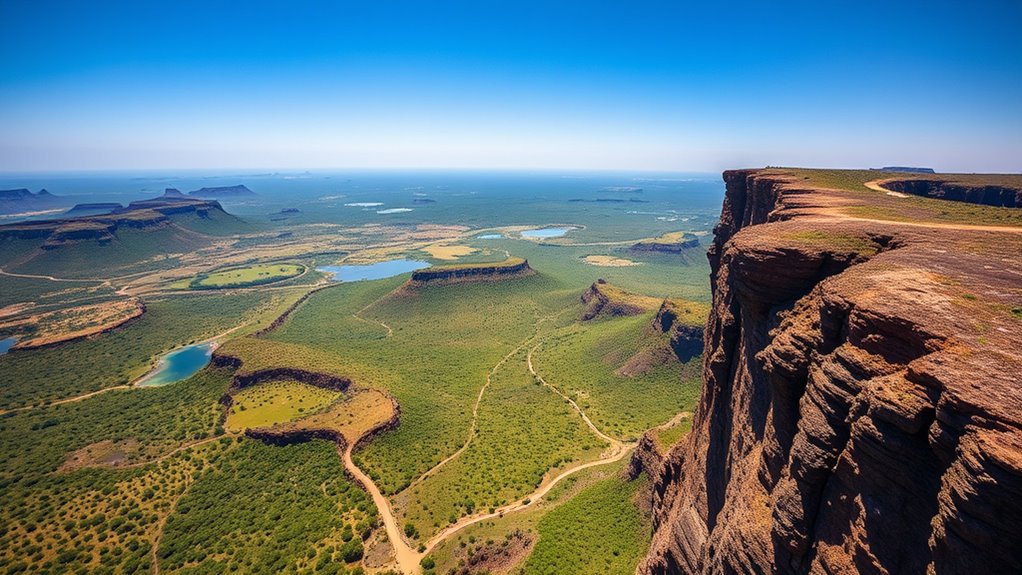
As you explore the Great Rift Valley Escarpment, you’ll be treated to breathtaking scenery and stunning views at every turn. You can also enjoy exciting activities like wildlife safaris and adventure outings that bring you face-to-face with nature. These sites and experiences make the area a must-visit for any adventure seeker or nature lover.
Spectacular Scenery and Views
Standing atop the Great Rift Valley Escarpment offers some of the most breathtaking panoramic views in Kenya. As you gaze across the vast landscape, you’ll see a mosaic of lush lakes, rolling hills, and distant mountains blending seamlessly. The scenery is ever-changing with the sunlight, creating stunning reflections on the water. Here are three must-see sights:
- The shimmering waters of Lake Naivasha, surrounded by green wetlands and dotted with flamingos.
- The dramatic cliffs and valleys that stretch endlessly, showcasing millions of years of geological history.
- The expansive vistas over the Maasai Mara plains, where wildlife roams freely against a backdrop of vivid sunsets.
Each view invites you to pause and marvel at nature’s raw beauty.
Adventure and Wildlife Encounters
Exploring the Great Rift Valley offers thrilling adventure and unforgettable wildlife encounters. You can set out on a safari in Maasai Mara or Lake Naivasha, where lions, elephants, giraffes, and flamingos roam freely. Walking safaris allow you to experience the wilderness up close, guided by expert trackers. For a more adrenaline-pumping experience, try hot air balloon rides over the valley at dawn, offering panoramic views of wildlife below. Birdwatchers will love the diverse species at lakes and wetlands. You might also visit local Maasai villages to learn about indigenous culture and traditions. Whether you’re tracking big game, birding, or engaging with local communities, the area promises authentic, immersive adventures that create lasting memories. Additionally, sustainable tourism efforts help preserve these incredible landscapes and ensure that future generations can enjoy their beauty.
Frequently Asked Questions
What Are the Local Cuisines to Try Along the Rift Valley Route?
When exploring the Rift Valley route, you should definitely try local cuisines like ugali, a maize porridge, and sukuma wiki, sautéed greens. Sample fresh fish from Lake Naivasha, such as tilapia, often grilled or fried. Don’t miss traditional nyama choma, grilled meat served with vegetables. You’ll also enjoy spicy samosas and mandazi, sweet fried dough. These flavors give you a true taste of Kenya’s vibrant culinary heritage along the Rift Valley.
Are There Guided Tours Available for Exploring the Escarpment?
Yes, guided tours are available for exploring the escarpment. You can join organized trips led by knowledgeable guides who take you to key viewpoints, cultural sites, and scenic spots along the route. These tours often include transportation, expert commentary, and sometimes local interactions, making your experience more enriching and safe. Booking in advance guarantees you get the best options, so you can fully enjoy the stunning landscapes of Kenya’s Great Rift Valley.
How Accessible Are the Remote Communities in the Rift Valley?
You’ll find that many remote communities in the Rift Valley are quite accessible, especially with local guides and proper transportation. Roads vary from well-maintained to rugged, so it’s essential to plan ahead. You can hire 4×4 vehicles or join organized tours to reach these areas comfortably. While some spots are still isolated, local communities often welcome visitors, offering cultural experiences that are well worth the effort to visit.
What Safety Measures Should Travelers Consider During the Drive?
Imagine steering a roller coaster that dips and climbs through the sky—safety is key. You should always wear your seatbelt, check your vehicle’s condition, and carry a fully charged phone. Be cautious of changing weather, stay on marked roads, and travel with a guide if possible. Keep emergency supplies handy, and inform someone of your route. These measures help you enjoy the breathtaking views safely and avoid unexpected surprises.
Are There Any Conservation Projects Visitors Can Participate In?
You can actively participate in conservation projects while visiting Kenya’s Rift Valley. Many organizations welcome volunteers to help with wildlife protection, habitat restoration, and community education. You might assist in local conservation efforts or contribute to eco-tourism initiatives that promote sustainable practices. By engaging in these projects, you directly support preserving the region’s unique ecosystems and wildlife, ensuring future generations can enjoy this spectacular area.
Conclusion
As you traverse Kenya’s Great Rift Valley Escarpment, you’ll realize it’s truly a feast for the senses. From breathtaking landscapes to vibrant cultures, the region offers unforgettable experiences at every turn. Keep your eyes open and your spirit curious—this journey is a golden opportunity to connect with nature and tradition. Remember, the early bird catches the worm, so plan your visit wisely and seize the adventure of a lifetime.
